For the past few years we've celebrated ADHD Awareness Month by publishing our top tips on how to deal with executive dysfunction (which is often a symptom of people who have been diagnosed with ADHD, though not everyone who struggles with executive dysfunction has ADHD). This October, we’re back to provide more helpful tips. We want to continue to help people who are living with an ADHD diagnosis build executive function skills while also spreading ADHD awareness. Click here to see this year's new bonus tips!
For us Executive Function coaches, the final days of October mark the end of ADHD Awareness Month. For the past few weeks, we’ve been posting handy tips on how to overcome executive function disorder on our Facebook, Twitter, Instagram, and TikTok feeds to help parents and students address the academic challenges that come with the territory of having attention difficulties.
As our Halloween treat to our blog readers, we’ve selected our top 10 useful tips on how to deal with executive dysfunction to share with you in one neat package. Of course, a person need not have ADHD in order to benefit from this advice!
How to Manage Executive Dysfunction Problems
Executive functioning and symptoms of ADHD can be improved by a number of tools and systems that are easy to implement. If steps aren’t taken to manage deficits, academic performance and social life can be negatively impacted. Top tips on how to deal with executive dysfunction and ADHD used by our Executive Function coaches include:
- Use a digital calendar to manage your time
- Keep helpful resources like checklists and templates nearby & visible
- Break goals down into smaller 5-minute actions
- Create an organizational system to keep track of important physical items
- Plan and commit to short breaks between work sessions
- Color code study materials based on mastery to prioritize review
- Use habit-building apps to build consistency
- Reframe deadlines and helpful tools to prioritize responsibilities
- Practice mindfulness to build presence and attention
- Pre-plan your next action following a scheduled break
- Bonus: 3 more ADHD and executive function tips
Want to learn more about how to overcome executive dysfunction?
If you're wondering, "how can my child get out of executive dysfunction?", read on!
In addition to the actionable tips, it's helpful to build executive function skills to maximize ability to deal with some of the challenges associated with ADHD and executive dysfunction.
Improve Executive Function Skills With These Tips
1) Use Google Calendar or iCal to manage time effectively
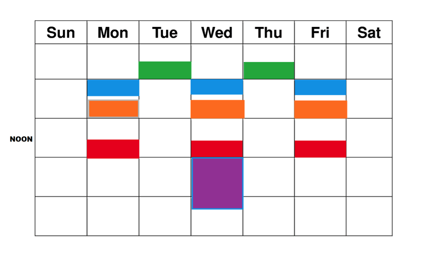
One of the key challenges that students with ADHD, learning differences or executive function disorders face is time management. It turns out that kids as young as 5th grade can benefit from online calendars. Both Google Calendar and iCal are cloud-based tools that can be synced between phone, tablet, and computer.
Many kids find visual representations of chunks of time in their day more useful than listing times (i.e., karate class 4:15-5:30), and the ability to color-code the time blocks makes it easier to quickly understand the different commitments that they are responsible for.
Take advantage of included features such as text reminders for appointments, color coding of different types of events, task lists with due dates, and the ability to schedule recurring events. Additionally, these calendars can be shared with coaches, parents, and other accountability partners.
2) Keep a folder of helpful resources to promote independence
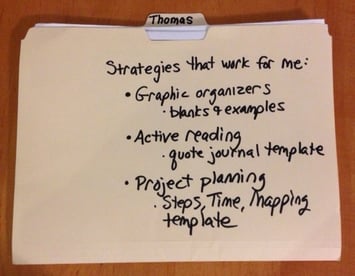 If you've been working with your child for some time, have you noticed that you've taken in a lot of information, tools, and approaches?
If you've been working with your child for some time, have you noticed that you've taken in a lot of information, tools, and approaches?
3) Try 5-minute goals
Sometimes big tasks are just too overwhelming. Either their scope is unmanageable or the actual steps to get there are unclear, which can lead to anxiety and disengagement.
Other times, the to-do list is longer than what can possibly be accomplished in a single sitting, and prioritization is required to increase effectiveness.
In either scenario, students can be coaxed out of their inaction by selecting a task that should take no more than 5 minutes, setting the timer, and springing into action. We have seen this tactic become a springboard for longer periods of work because it eliminates the friction of getting started. Sometimes, this kickstart leads to becoming immersed in the task and a productive 10, 20, 30 minutes, or more can follow.
4) Keep track of that paperback
 Students frequently misplace reading materials for English. That play or novel is another item to keep track of, a smaller object amidst the bulky binders and heavy textbooks.
Students frequently misplace reading materials for English. That play or novel is another item to keep track of, a smaller object amidst the bulky binders and heavy textbooks.
A three-hole-punched zippered pouch can work well as a dedicated holder for the current paperback your child’s class is reading. It can’t slip and slide its way to the bottom of the locker or scatter onto the floor in a rush to pack up at the end of class.
Want to take it a step further? A post-it note reminder attached to the front cover to return the book to its home often helps students maintain this habit because it's a visual cue that prompts the new, desired behavior.
5) Don't let breaks put the brakes on productivity
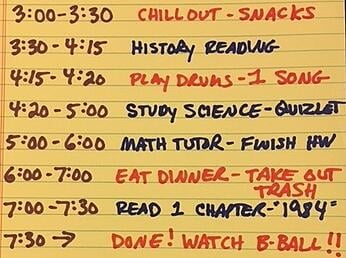
6) Color code to cruise through studying
You know that you stop at red traffic lights, slow down at yellow, and cruise through when it’s green. It also makes sense to manage study materials that way!
When kids have study guides for tests, they can start by color-coding them based on their level of mastery. Highlight in green what they know well. No need to spend a lot of time studying this material! Then, use yellow for what they “kinda-sorta know” to cue them to slow down and review. Any areas in red indicate a full stop: this content is totally unfamiliar to them.
By color-coding, students can spend time more effectively by focusing on the red and yellow material the most. This strategy can be folded into a larger spaced repetition study-based method like the one recommended in the book Make it Stick.
7) Use apps to help you stick with healthy or productive habits
Technology, when used as a tool instead of a distraction, can greatly aid your child's ability to stay on track and be productive.
Habit List reminds you daily of your goal and then tracks progress over time as you record it. Use it to remember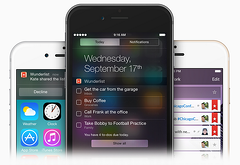 to exercise, sit down to do homework at a consistent time, review notes for classes, prepare your backpack for the next day, and more.
to exercise, sit down to do homework at a consistent time, review notes for classes, prepare your backpack for the next day, and more.
When students need to remember to take their medication, the MediSafe app can help. This app shows four screens for time zones in the day: morning, noon, evening and night. When you select a medication, it puts an actual graphic of what that pill looks like into the appropriate zone.
8) Transform the deadline mindset
 Encourage your child to look at deadlines in a different and more empowering light.
Encourage your child to look at deadlines in a different and more empowering light.
They say that "a goal is just a dream with a deadline". Well, a deadline can then be viewed as a helpful tool – they force you to make decisions and push forward, rather than dwelling on a specific aspect of a project for days!
This is a great executive function strategy, because when your child commits to a deadline, they can begin to focus on that important task or goal and put aside distractions.
Talk to your child about reframing his or her thoughts – don’t think of that upcoming due date as a burden, but rather look forward to it as a time when your work will be finished! In fact, calling it a "finish line" might help your child adopt a different mindset that emphasizes accomplishment instead of looming misery.
9) Give yourself a gift: Be present
One of the best test prep tips for any student whether they need to overcome executive dysfunction or not is to be focused in class. Every class period is an opportunity for greater mindfulness and presence. Students can prepare for class by doing assigned reading and homework and participate by reframing what they've heard and asking thoughtful questions.
The level of intensity of concentration while taking in these inputs as well as producing new connections will correspond to the acceleration of their learning and knowledge accumulation.
Each day new nuggets of knowledge will nestle into their neurons!
It turns out that learning is most effective in these smaller, more intensely focused chunks over time. Students aren’t simply biding time until baseball practice or play rehearsal during class. The savvy ones know that they are preparing for the exam while dissecting that sheep’s lung in biology.
10) Prepare to dive in after a break
Study breaks are most effective when students have a clear sense of what they will do once they get back to  work and do some quick preparation before taking a pause.
work and do some quick preparation before taking a pause.
Your child can rethink the structure of their working sessions: 5-minute goal ("task initiation"), deep work (20 minutes), reflection & planning of the next 5-minute goal (5 minutes). This work block could be followed by a 10-minute break.
Here's how the setup and planning for the next 5-minute goal could look in practice: before taking a break, open up that textbook to the reading that needs to be done. Set out the graph paper and pencil for the math homework. Write down one simple bullet point about the next action you'll take when you resume.
This one-minute prep can help students who have a hard time starting work after a break.
Top tips for dealing with executive dysfunction
To recap, here are top strategies to improve executive functioning recommended by experts:
- Use Google Calendar or iCal to manage time effectively
- Keep a folder of helpful resources to promote independence
- Try 5-minute goals
- Keep track of that paperback
- Don't let breaks put the brakes on productivity
- Color code to cruise through studying
- Use apps to help you stick with healthy or productive habits
- Transform the deadline mindset
- Give yourself a gift: Be present
- Prepare to dive in after a break
Bonus: 6 more ADHD and executive function tips
1) Encourage Ownership
Offer your child opportunities to brainstorm other solutions for the challenges they face. Remember, to see results, your child's goal needs to emerge from them truly wanting to improve something about their life. (In other words, just because you may want them to finish their homework by 8:00pm doesn't necessarily mean they want that as their goal.) This is especially true when it comes to those with ADHD as their brain’s reward system is particularly bad at faking enthusiasm (read more about that here.)
2) Keep It Simple
Focus on one goal area at a time. Even though we may have several things we want to improve, if we get overwhelmed by trying to accomplish too much, we will be right back where we started. So consider this: what is it that your child believes they could benefit from the most? Being more organized? Managing time better? Staying focused in class? Planning ahead? Managing frustration? Start with the biggest pain point first and let the small bits of progress provide a foundation for the big transformations. Speaking of which…
3) Track Your Progress and Celebrate the Wins (no matter how small!)

Each week, encourage your student to track what efforts they’re making towards their goals and to reflect on the process week-week Habit tracking systems like the one we covered in our podcast recently are great approaches, but you can also do this by simply asking good leading questions each week such as…
Have you stuck to your goal? If not, what is holding you back? Was it a realistic one or is there something you need to change to make it more attainable? What specifically will you do next week to get a little closer to success?
As you both continue to reflect on those efforts, you will certainly see small wins. Maybe they kept track of their homework in a planner for 1 week straight or woke themselves up in the morning a few times. No matter what those small wins are, celebrating them will help your student feel proud of the things they are accomplishing and that pride can be the catalyst for more wins. Your student may not have all the pieces in place yet, but with time and effort, you’ll likely be blown away by what they’re able to accomplish - in the classroom, at home, and far beyond.
4) Use Stress Management Tactics
Executive dysfunction problems can cause your child to fall behind on their classwork and become overwhelmed by their workload. Unfortunately, stress can increase executive dysfunction, in turn making it more difficult to cope with stress. It’s a vicious cycle!
Teaching your child stress management techniques can make a huge difference in their executive functioning and their emotional regulation skills. Try a quick and easy breathwork tool with your child by having them breathe in as you count to 4 and slowly breathe out as you count to 8. Repeat this a few times until they begin to feel more relaxed.
More of our favorite stress relief techniques include mindfulness practices, meditation, exercise, fun visualization exercises, and journaling. Once you find a practice that works for your child, encourage them to participate in it regularly for long-term prevention against chronic stress and improved executive functioning.
5) Designate a Space for Homework and Studying
Choosing one space for a student to complete their schoolwork can be a valuable executive functioning strategy as it provides structure and minimizes the environmental distractions that are often present in a new place. The area you pick should be quiet and free from people or items that could hurt their focus.
It’s important to keep their study space free from clutter and mess, as having too many things around can worsen executive functioning and make it harder for students to complete their work. It should also contain all the supplies and tools they need to properly finish their homework. Organizational products can be very helpful for keeping supplies within arms reach without causing clutter.
6) Get Their Teachers Involved
Taking actions to improve executive function at home and school can help your child see greater improvement in their academic performance. Teachers are a valuable asset as they spend a large chunk of the day with your child and can help you keep an eye on their progress.
Many teachers have helped students with executive function deficits in the past and can provide incredible executive function tips and even more ways to tackle challenges. One specific way teachers can help your student is by providing detailed instructions for assignments. You can take these instructions and help your child break their work up into smaller tasks that are easier to complete.
If your child’s teachers know about their executive dysfunction, they’ll be sure to point out any wins or struggles that may occur during their time in the classroom. This can be very helpful when figuring out which aspects of executive functioning your student needs extra support with.
Action makes the difference in overcoming "executive function disorder"
Now you are armed with some of our coaches' favorite tips for how to cope with executive dysfunction. Use them to help your child stay organized, study effectively, increase productivity, and manage time better. Maybe you even found a tip or two that you might try for yourself. Hey, sharing is a good thing, right? Kind of like when your little Batman or Wonder Woman walks in the door with a surplus of peanut butter cups on Halloween...
(As you sort through the different terminology used in the world of executive dysfunction, it's useful to note that there is no recognized diagnosis of "executive function disorder"; rather, researchers often classify ADHD as a disorder of Executive Function.)
What to do if your child is struggling with ADHD, executive dysfunction, or learning challenges
Because these conditions sometimes lead to a skills gap that prevents kids from achieving the success they are capable of in and out of the classroom, it's best to create a treatment plan in coordination with your licensed medical professional, therapists, teachers, and other providers.
At Beyond BookSmart, we are dedicated to teaming up with parents and students to achieve results that aren't addressed by medication, cognitive behavioral therapy, and other treatments alone.
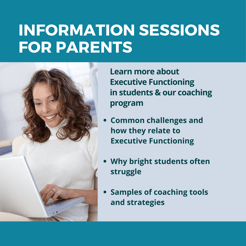 Watch our brief on-demand information session for parents to learn more about how coaching helps students succeed.
Watch our brief on-demand information session for parents to learn more about how coaching helps students succeed.
.

